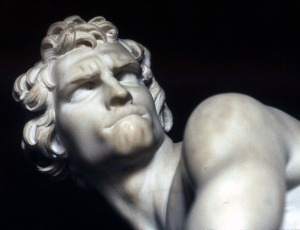
Today in Rome, north of the Spanish Steps and the old city center is a large open park called the Borghese gardens. They at one time belonged to the Borghese family, who were at the top of Rome’s wealthy upper-class elites.They produced a Pope (Pope Paul V), who upon becoming Pope placed family members in areas of power throughout the church, further increasing their wealth and influence. The Pope’s nephew was Scipione Borghese, seen in this picture to the right in a portrait bust by Bernini. Scipione (pronounced Ship-eee-own) was a Cardinal in the church and a great patron of the arts. He built the family estate and the Borghese gardens, and set about commissioning great works of art to fill it. He was a key collector and patron of Caravaggio’s paintings, and discovered the young Bernini, who became his private sculptor from 1618 to 1624.
Bernini was to become the greatest Baroque sculptor, redefining the limits of the medium. There’s a reason why sculptures often show figures in still, heroic poses: for the artist, it’s easier to carve a still figure than one in motion, and that’s just the way it had always been, with notable exceptions like the Laocoon, see here.  Bernini pushed sculpture to levels of complexity that were unheard of. He saw his figures at moments of high action, in motion and in the act of transformation. It’s a common theme to his work. Consider this work of an amazingly expressive screaming man, called “The Damned Soul”. It’s actually a self portrait sculpture of Bernini, one he made by allegedly holding his hand over an open flame to study the facial distortions of his painful screams.
Bernini pushed sculpture to levels of complexity that were unheard of. He saw his figures at moments of high action, in motion and in the act of transformation. It’s a common theme to his work. Consider this work of an amazingly expressive screaming man, called “The Damned Soul”. It’s actually a self portrait sculpture of Bernini, one he made by allegedly holding his hand over an open flame to study the facial distortions of his painful screams.
He was a young man in his years sculpting for Scipione, only in his 20s. Yet, he made some of his most enduring sculptures at that time. This includes his energetic “David”- who intently prepares to release the stone on Goliath, and his mythological “Apollo and Daphne”, depicting the very moment Daphne transforms into a tree. For analysis on those sculptures and a great film on Bernini, check out this earlier POST.
The other masterpiece Bernini made in the period is the “Rape of Persephone”, also called “Pluto and Proserpina”. The word rape is a strong word- to Bernini in this work, it meant “abduction”.  What we see is Pluto(also called Hades), the powerful god of the underworld, kidnapping Persephone and carrying her away. In true Bernini fashion, the act is captured at a moment of intense motion and struggle.She twists her body to free herself, resisting Pluto by pushing against his forehead with her hand. Her other arm is outstretched for help. It’s hard to see her face, but she screams in agony as visible tears, carved into the marble, slide from her eyes and down her cheeks. An elaborate drapery flows in the wind and captures the movement of the struggle as Pluto reaches across his body and grabs onto her thigh. Bernini envisioned the sculpture as an unfolding event, one that could be read from 3 sides. From the left, seen here, we see the initial struggle and resistance of Persephone. From the front, Pluto is seen arriving in the underworld, and appears in command of his captured victim. From the right, we see the aftermath and the three-headed dog Cerberus (who guards the underworld) along with Persephone’s tears.
What we see is Pluto(also called Hades), the powerful god of the underworld, kidnapping Persephone and carrying her away. In true Bernini fashion, the act is captured at a moment of intense motion and struggle.She twists her body to free herself, resisting Pluto by pushing against his forehead with her hand. Her other arm is outstretched for help. It’s hard to see her face, but she screams in agony as visible tears, carved into the marble, slide from her eyes and down her cheeks. An elaborate drapery flows in the wind and captures the movement of the struggle as Pluto reaches across his body and grabs onto her thigh. Bernini envisioned the sculpture as an unfolding event, one that could be read from 3 sides. From the left, seen here, we see the initial struggle and resistance of Persephone. From the front, Pluto is seen arriving in the underworld, and appears in command of his captured victim. From the right, we see the aftermath and the three-headed dog Cerberus (who guards the underworld) along with Persephone’s tears.
It’s a truly amazing sculpture that boasts one of the most remarkable detail images in all of sculpture. As Pluto grabs Persephone’s thigh, Bernini has carved the veins and tendons below the skin of hands, and the indentation of flesh on her leg. It’s one of those images that’s so astonishingly real, it is often mistaken for a photograph when you see reproductions. All this is made even more impressive when you consider it’s stone, carved nearly 400 years ago by a sculptor only 23 years old.
Was this article worth 1$? If so, help me out so I can make this site better and generate new content… thanks!









